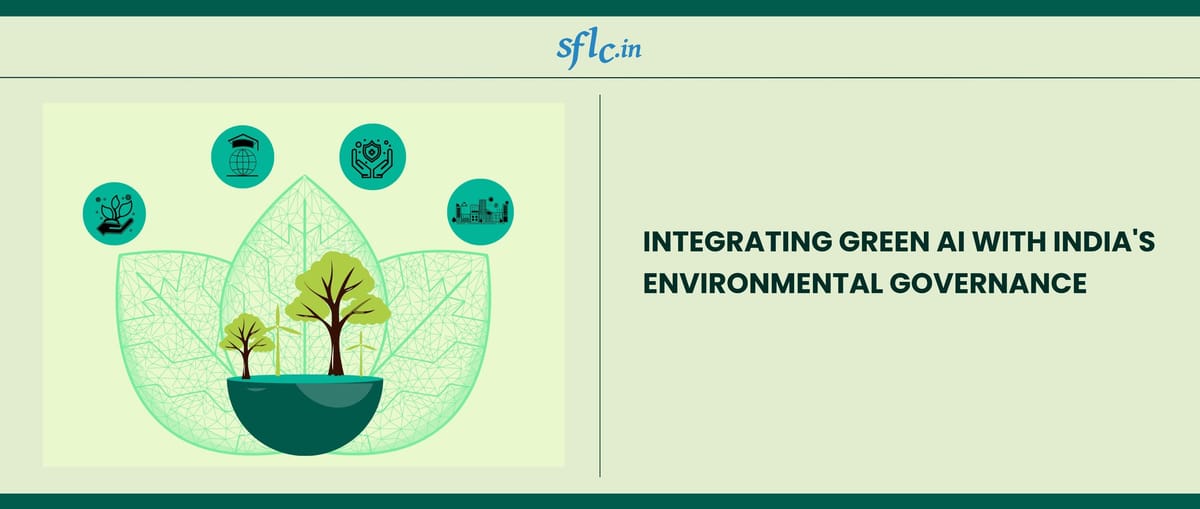India’s national AI strategy spearheaded by Niti Ayog in 2018 and initiatives (e.g. the IndiaAI Mission) emphasize economic growth, social good and addresses national challenges, positioning itself as a Global leader in AI. However, official AI policy documents largely overlook AI’s environmental costs. Despite its transformative potential, artificial intelligence (AI) carries an often-overlooked environmental cost: both training and inference phases can consume vast amounts of electricity and water. Yet tech giants have released scant data on their true carbon footprint, leaving AI’s climate impact largely opaque. In India, the fast growth of data‐centre capacity, fueled by massive AI workload is projected to grow at a CAGR of 24.68% from 2023 to 2029. This boom is expected to drive global electricity demand from these facilities to 1,580 TWh by 2034 equivalent to total energy consumption of India. Domestically, it places increased pressure on a grid that remains fossil fuel‐dependent and increases regional water stress for cooling.
For instance, each time you interact with ChatGPT, it consumes approximately 0.14 kilowatt-hours (kWh) of electricity—enough to power 14 LED bulbs for an hour. Additionally, processing 10 to 50 queries can use upto 2 liters of water, primarily for cooling the servers in data centers.
This overview of the problem directs us to a crucial policy tension which is at play here and necessitates a robust AI governance across AI value chain fixing liabilities of all the actors. With a vision of sustainable green innovation in the AI ecosystem, Indian policymakers must reconcile two priorities: supporting AI innovation along with ensuring AI infrastructure is energy-conscious.
Green AI—the design and deployment of AI models with the least possible carbon impact, being energy efficient right from the research phase to deployment stage—is an attractive answer to this dilemma. Yet India's foundational legislation of environmental governance, ranging from the Environment (Protection) Act 1986 to the EIA Notification 2006, does not presently include computational emissions in their vocabulary or require energy efficiency in digital infrastructure, resulting in a regulatory void as the country speeds up its AI push. In fact, the National Data Centre Policy 2020 of the Ministry of Electronics and Information Technology, largely maintains silence on the environmental impact of these data centres and only encourages use of renewable energy rather than mandating use of Green energy.
India’s Evolving AI governance
India’s AI governance model is still developing. The NITI Aayog’s National Strategy for AI (2018) and related “AIforAll” efforts prioritize AI applications in healthcare, agriculture, education, smart cities and transport, with scant mention of AI’s own energy footprint. Likewise, the approved IndiaAI Mission (March 2024) allocates INR 10,371 cr to expand compute capacity and innovation make no express call for sustainability. By contrast, some draft guidelines and committees have begun to note AI’s power demands. For example, the MeitY Report of Committee A on Platforms and Data on AI (2019) explicitly recommends incentivizing “green energy” for data centers. Likewise, a draft Data Centre Policy (NITI, 2020) calls for renewable power options and “efficient utilization of energy … for reducing the carbon footprint of the Data Centres”. An IndiaAI subcommittee on AI governance (2023) even proposed developing metrics to measure the “environmental impact of AI in India”. These scattered references indicate growing awareness but no binding regulations yet. Notably, the Ministry of Power and Ministry of Environment have not issued specific AI-environment guidelines and frameworks, though the Power Ministry’s planners are studying data center load patterns (Central Electricity Authority discussions, 2024) and stakeholders report inter-ministerial talks on AI data-center power supply. Overall, official AI strategy documents to date emphasize speedy AI deployment, with only piecemeal attention to energy efficiency or emissions.
Now is the time to escalate discussions on how focused amendments and fresh regulations—broadening Environmental Impact Assessments (EIAs) to AI facilities, putting data centres on the PAT scheme, introducing "Green AI" certificates, making life cycle assessments and carbon labels mandatory, enforcing renewable‑energy adoption, and promoting innovation centers—can integrate sustainability into India's AI ecosystem, so that technological progress and environmental responsibility move together.
Expanding Environmental Impact Assessments to Cover AI Facilities
India’s EIA Notification 2006 classifies only heavy industries (steel, cement, thermal power, mining) in Schedules ‘A’ and ‘B’, with no reference to data centres or AI compute farms. A draft amendment could add a new “Green-B” entry:
“All greenfield and brownfield data-centre complexes with aggregate IT load ≥ 5 MW or annual energy consumption ≥ 20 GWh—including AI-optimized compute farms—shall require Category A environmental clearance.”
Under this change, developers would need to quantify Scope 2 emissions (electricity use) and water usage (cooling-water withdrawal) in their impact statements. Critically, India should mandate disclosure of the trinity of operational metrics—Power Usage Effectiveness (PUE), Water Usage Effectiveness (WUE), and Carbon Usage Effectiveness (CUE)—as part of project evaluation. This trio should become the new standard for defining a green data centre in India, aligning environmental audits with the realities of digital infrastructure. In doing so, local communities, regulators, and planners would gain visibility into the resource intensiveness of AI projects, enabling more informed public consultations and ensuring energy-water-climate trade-offs are evaluated before clearance is granted.
Energy‐Efficiency Mandates under the Energy Conservation Act
The Energy Conservation Act of 2001, as implemented by the Bureau of Energy Efficiency (BEE), presently identifies nine energy-intensive industries like aluminium, cement, and thermal power as "Designated Consumers" (DCs). These industries are required to get their energy audits done and follow certain energy consumption standards. Interestingly, data centres, with their fast-growing energy requirements, are not yet considered DCs.
Given the exponential growth of data centres, particularly those supporting AI workloads, there's a compelling case for their inclusion under the DC framework. A Section 14 notification could explicitly add:
“Data‑centre operators with an aggregate IT load ≥ 50 MW are hereby notified as ‘designated consumers’ for mandatory energy audits and compliance with a PUE benchmark not exceeding 1.4, subject to penalties for non‑compliance.”
The "Accelerating Energy Efficiency in Indian Data Centers" program, spearheaded by the Confederation of Indian Industry (CII) in partnership with Lawrence Berkeley National Laboratory (LBNL) and guided by BEE, has been instrumental in formulating energy efficiency standards specific to data centres. Energy Conservation Building Code (ECBC) 2017, published by the BEE, Ministry of Power is aimed at providing design and construction requirements for energy-efficient buildings in India, including data centers.
In addition, the Energy Conservation (Amendment) Act 2022 enables the Central Government to prescribe a minimum proportion of energy use from non-fossil fuels for targeted consumers, which is in consonance with India's overall decarbonization ambitions.
“Green AI” Certification through the PAT Scheme
India’s PAT (Perform, Achieve and Trade) the scheme has proven the power of market‑based energy savings certificates (ESCerts), generating tradable credits that reward efficiency gains in designated industries with over 100 crore market transactions to date. A parallel “Green AI” certificate could represent one MWh of verified annualized energy savings from optimized AI workloads, allowing data‑centre operators and AI providers to monetize improvements in model and hardware efficiency.
These certificates could be used by under‑performing designated consumers to meet compliance or by investors seeking green assets—thereby catalyzing low‑carbon innovation in AI system design and deployment.
Mandatory Life Cycle Assessments and Carbon Labelling
Comprehensive Life Cycle Assessments (LCAs) evaluate greenhouse‑gas emissions from a product’s cradle to grave, providing a trusted framework for environmental transparency. Requiring AI service providers to publish a standardized “Lifecycle Impact Report” at model launch—including total training energy (kWh), average inference energy per query (J/query), and embodied hardware emissions (kg CO₂e)—would mirror global best practices .
Third‑party audits and a central public registry under the EPA would enable regulators, enterprises, and civil‑society to compare AI offerings on a “carbon‑nutrition‑label” basis, spurring competition on sustainability as well as performance.
Renewable‑Energy Procurement and Green Financing
To honor India’s Nationally Determined Contribution submitted to UNFCCC of 50 % non‑fossil electricity capacity by 2030, it has achieved a new milestone of more than 46.3% of renewal energy based electricity generation capacity. Likewise, data centres above 10 MW should be mandated to source at least 60 % of their annual power from renewables—rising to 100 % by Green financing vehicles, such as the secured green bonds issued by IREDA raised
INR 19.5 billion masala bonds in September 2017 and INR 9.10 billion in Tier II bonds in March 2025. It can be earmarked for renewable‑backed AI infrastructure, lowering the cost barrier for hyperscalers to transition to clean energy.
Outpacing nations like the United States in renewable‐energy output, India has established itself as a pioneer in the shift toward clean power and is ideally positioned to meet its data‑centre sustainability goals through expanded clean‑energy integration. Nevertheless, as data centres expand rapidly, India must accelerate its renewable‑energy rollout to keep pace with its sustainability ambitions.
Strategic Siting of AI Data Centres
India’s data‑centre capacity is highly concentrated in major hubs—Mumbai (536 MW), Chennai (113 MW), Bengaluru, Hyderabad, Pune, and the NCR—leveraging existing fiber and talent infrastructure but exerting intense pressure on local power grids and water resources. Emerging Tier II and Tier III cities are increasingly hosting data‑centre projects, with capacity outside metro areas growing rapidly, thereby alleviating urban grid stress and fostering regional economic development.
Coastal locations offer sustainable advantages: abundant seawater for direct cooling (reducing both PUE and WUE), proximity to onshore wind and solar farms (cutting transmission losses and land‑acquisition costs), and the ability to ring‑fence renewables‑backed microgrids to minimize strain on distribution networks. Policy incentives—such as expedited environmental clearances and reduced water‑use fees for coastal or renewable‑backed sites—can nudge developers toward greener siting, while higher water tariffs and stricter permitting in inland, water‑scarce regions.
What is Shaping Globally
France’s REEN law mandates that digital‑service providers report their resource and carbon footprints, including data centre energy use, thereby raising transparency and driving efficiency improvements. The EU AI Act mandates that high‑risk AI providers document the energy consumption and environmental risks of their systems, and paves the way for eco‑design criteria for servers and compute hardware. The EU AI Act further requires the Commission to develop and update standards for energy‑efficient deployment of AI models but still it lacks focus on other critical environmental concerns. But these laws laid down the groundwork for an environmental regulatory framework that India’s Bureau of Indian Standards (BIS) could adapt in national AI governance.
India’s aspirations as a global AI leader and its climate commitments need not be in conflict, but thoughtful governance is essential. To date, Indian policy has largely treated AI as an economic and strategic priority, with only isolated acknowledgments of energy footprints. AI’s environmental footprint is significant, but its mitigation potential positions it to be both a challenge and a solution for climate action. The IEA estimates that broad AI‑led solutions could reduce energy‑related emissions by around 5% and up to 8% in electronics manufacturing, while the World Economic Forum projects that AI could abate 5–10% of global greenhouse‑gas emissions by 2030. A legal architecture for Green AI—spanning EIAs, energy‑efficiency mandates, tradable Green AI credits, lifecycle transparency, renewables procurement, green financing, innovation hubs, and strategic siting—can turn India’s AI surge into a model of digital sustainability.


